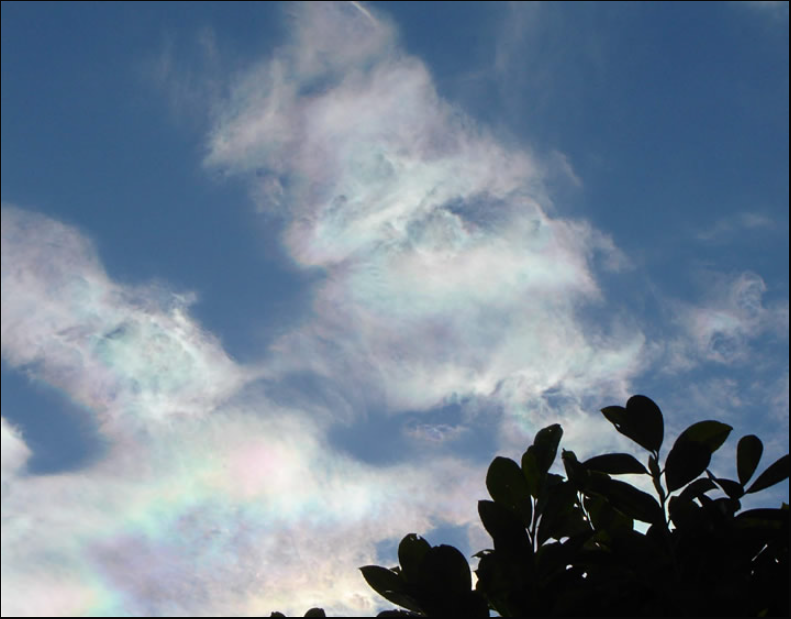Iridescent Clouds
Exploring the Enigmatic Beauty of Iridescent Clouds
Iridescent clouds, also known as rainbow clouds, are a captivating atmospheric phenomenon that has fascinated observers for centuries. These ethereal displays of color are created by the scattering of light waves by very small cloud droplets and ice crystals. However, despite the potential for iridescent colors, most clouds appear white or lack the vibrant hues typically associated with iridescence. So, why do some clouds exhibit these mesmerizing colors while others do not?
The answer lies in the size and distribution of the cloud droplets. In thick clouds, where there is a high concentration of droplets, sunlight is scattered by numerous droplets. As a result, the angular information of the scattered light is lost, causing the colors to mix and appear as white to the human eye. This phenomenon is commonly observed in mature clouds where droplets of various sizes coexist.
However, when clouds are freshly formed and thin, their droplets tend to have similar sizes. In these conditions, when sunlight interacts with a single droplet, the iridescent colors that tiny drops and crystals always produce become visible to us. It is during these moments that we are treated to the breathtaking spectacle of iridescent clouds.
Let us delve deeper into the factors that contribute to the formation of iridescent clouds:
-
Droplet Size Homogeneity: The presence of cloud droplets that are uniform in size enhances the likelihood of iridescence. When droplets have similar dimensions, light waves undergo constructive and destructive interference, resulting in vivid coloration.
-
Sun Angle: The angle at which sunlight interacts with the cloud droplets plays a crucial role in the visibility of iridescence. The optimal conditions for observing iridescent clouds occur when the sun is relatively low on the horizon, such as during sunrise or sunset.
-
Cloud Thickness: Thin clouds allow sunlight to pass through and interact with individual droplets more effectively. This unimpeded interaction intensifies the scattering of light and enhances the iridescent effect.
-
Cloud Altitude: The altitude at which the cloud forms also influences the presence of iridescence. Higher-altitude clouds, such as cirrus clouds, are more likely to exhibit iridescent colors due to the presence of ice crystals.
-
Atmospheric Conditions: Atmospheric conditions, such as humidity and temperature, can impact the formation of iridescent clouds. These conditions determine the size and composition of the cloud droplets, ultimately influencing the potential for iridescence.
-
Geographical Location: Certain regions are more prone to witnessing iridescent clouds due to specific atmospheric conditions prevalent in those areas. For example, mountainous regions or areas with high levels of moisture in the air may provide a more favorable environment for the formation of iridescence.
The beauty of iridescent clouds lies in their transient nature. These captivating displays often last only for a brief period, making them all the more elusive and enchanting. To maximize your chances of witnessing this natural phenomenon, keep an eye on the sky during sunrise or sunset when the sun's angle is lower, and look for thin, newly formed clouds with uniform droplet sizes.
Remember, while iridescent clouds are undoubtedly a sight to behold, they are a product of natural optical phenomena and should not be mistaken for signs of impending extreme weather events. So, next time you find yourself gazing at the sky, take a moment to appreciate the captivating beauty of iridescent clouds and marvel at the wonders of our atmosphere.

Iridescent Clouds imaged by Antonino Gumina, Milan, Italy. ©Antonino Gumina, shown with permission.
All very small cloud droplets and ice crystals scatter light waves to produce colours at particular angles from the sun.
Why then are clouds white or at least not full of iridescent colours?
In thick clouds most sunlight is scattered by many droplets. The angular information is lost and the colours mix to white.
Most mature clouds have a range of droplets sizes and, again, the colours are smeared out to white.
But when clouds are freshly formed and thin their droplets have similar sizes and many sun rays only interact with one drop. Then we see the iridescent colours that tiny drops and crystals always produce.
Note: this article has been automatically converted from the old site and may not appear as intended. You can find the original article here.
Reference Atmospheric Optics
If you use any of the definitions, information, or data presented on Atmospheric Optics, please copy the link or reference below to properly credit us as the reference source. Thank you!
-
<a href="https://atoptics.co.uk/blog/iridescent-clouds-9/">Iridescent Clouds</a>
-
"Iridescent Clouds". Atmospheric Optics. Accessed on November 26, 2024. https://atoptics.co.uk/blog/iridescent-clouds-9/.
-
"Iridescent Clouds". Atmospheric Optics, https://atoptics.co.uk/blog/iridescent-clouds-9/. Accessed 26 November, 2024
-
Iridescent Clouds. Atmospheric Optics. Retrieved from https://atoptics.co.uk/blog/iridescent-clouds-9/.